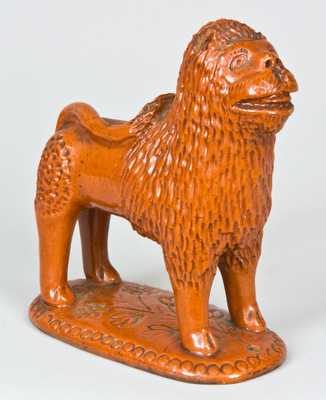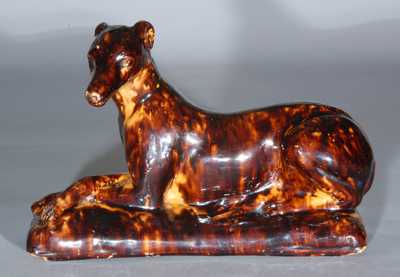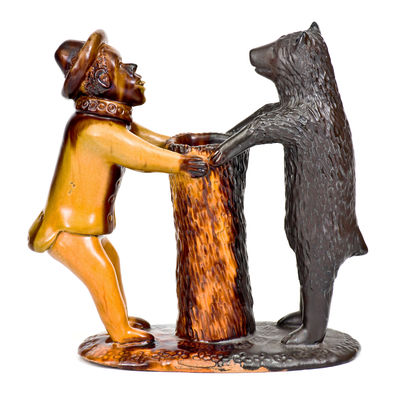Highly Important Cobalt-Decorated Stoneware Presentation Spaniel on Base, Inscribed "Frank Hamilton / Greensboro / Penna," Signed "Jas. H. Atchison," Greensboro, PA origin, circa 1875, molded figure of a seated spaniel 0n octagonal base, featuring spotted cobalt decoration throughout the animal's body, a spotted collar with brushed locket around its neck, and an incised mouth and eyes with cobalt pupils. Base incised on front with the cobalt-highlighted inscription, "Frank Hamilton / Greensboro / Penna.," including incised vining in the Western Pennsylvania style, all within a cobalt-highlighted border. Top of base incised with the potter's signature, "Jas. H Atchison." Featuring one of the most coveted forms in all of Western Pennsylvania stoneware, this work is regarded as highly important based on the person for whom it was made, potter Frank Hamilton (1846-1921). Hamilton is one of the most recognizable figures in the story of Western Pennsylvania's stoneware industry. He was co-founder and partner in the famous Hamilton & Jones pottery in Greensboro, today regarded as one of the country's leading producers of 19th century salt-glazed stoneware. He established this operation with John Jones, the son-in-law of William "Leet" Hamilton, in 1866. Regarding his swift ascendance to pottery ownership, Hamilton is described in Schaltenbrand's Stoneware of Southwestern Pennsylvania as having "earned a reputation as a skilled potter and. . . one of the few in the district who could turn the largest of vessels 'with ease'" (Schaltenbrand, p. 54). Hamilton & Jones built a wide market for their ware even outside of Pennsylvania, producing a variety of stenciled pieces bearing the names of merchants operating in Southern, Mid-Atlantic, and Midwestern states. The large body of surviving freehand and stencil-decorated stoneware bearing the Hamilton & Jones name attests to the artistic quality, influence, and success of this firm. The Hamilton & Jones pottery would survive until 1897, when it was destroyed by fire. Hamilton, however, is believed to have established another pottery a few years later in nearby New Geneva. Partnering with a man named Arthur Robbins, Hamilton ran the business from 1900-1914, producing the last cobalt-decorated stoneware in the region and witnessing firsthand the craft's demise (Schaltenbrand, p. 97). The signature incised behind the dog indicates it was made as a gift for Hamilton by fellow potter, James H. Atchison (b. circa 1850), the son of potter Henry K. Atchison (1820-1893) who is best known as a stoneware manufacturer in New Geneva, across the Monongahela River from Greensboro. A small group of signed spaniels from the same mold indicate Atchison favored this form and that he was possibly Greensboro's leading producer of these special pieces. This spaniel, fashioned with a broad vent hole in the underside extending into the deeply-hollowed body of the animal, displays the potter's care in creating a successfully fired sculpture. Lacking any in-the-firing damage, the spaniel also exhibits a superb, light-gray coloration, bright cobalt, and uniform salt glazing throughout. Among the finest examples of Western Pennsylvania stoneware to come to auction in the last decade or more, this spaniel combines high visual appeal, rarity of form, and remarkable significance to the history of American stoneware. Literature: For a spaniel from the same mold, also signed by Atchison, see Made in Pennsylvania: A Folk Art Tradition, cover and p. 69. Excellent condition with a minor chip to foot of base on reverse, a 1/2" surface line to foot of base on reverse (not visible on interior), some extremely minor surface crazing to base (not visible on interior), and two tiny chips to top of base. H 10 1/4" ; L (of base) 8 1/4".


































